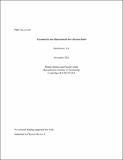| dc.contributor.author | Hutchinson, Ian H. | en_US |
| dc.date.accessioned | 2025-03-21T20:19:47Z | |
| dc.date.available | 2025-03-21T20:19:47Z | |
| dc.date.issued | 2021-11 | |
| dc.identifier | 21ja107 | |
| dc.identifier.uri | https://hdl.handle.net/1721.1/158683 | |
| dc.description | Submitted for publication in Physical Review E | |
| dc.description.abstract | Slow solitary positive-potential peaks sustained by trapped electron deficit in a plasma with asymmetric ion velocity distributions are in principle asymmetric, involving a potential change across the hole. It is shown theoretically how to construct such asymmetric electron holes, thus providing fully consistent solutions of the one-dimensional Vlasov-Poisson equation for a wide variety of prescribed background ion velocity distributions. Because of ion reflection forces experienced by the hole, there is generally only one discrete slow hole velocity that is in equilibrium. Moreover the equilibrium is unstable unless there is a local minimum in the ion velocity distribution, in which the hole velocity then resides. For stable equilibria with Maxwellian electrons, the potential drop across the hole is shown to be Delta\phi= 2/9 f''' (Te/e) (e\psi/m_i)^2 , where \psi is the hole peak potential, f''' is the third derivative of the background ion velocity distribution function at the hole velocity, and Te the electron temperature. Potential asymmetry is small for holes of the amplitudes usually observed, <~0.5Te/e. | |
| dc.publisher | APS | en_US |
| dc.relation.isversionof | doi.org/10.1103/physreve.104.055207 | |
| dc.source | Plasma Science and Fusion Center | en_US |
| dc.title | Asymmetric one-dimensional slow electron holes | en_US |
| dc.type | Article | en_US |
| dc.contributor.department | Massachusetts Institute of Technology. Plasma Science and Fusion Center | |
| dc.relation.journal | Physical Review E | |
